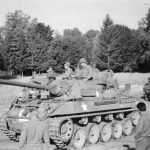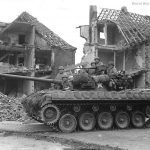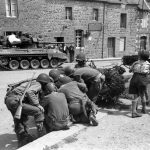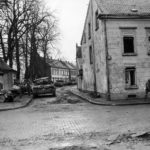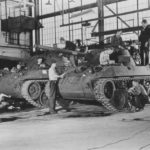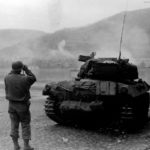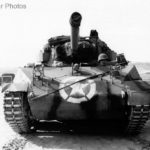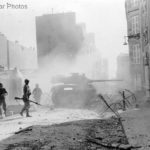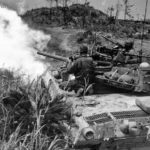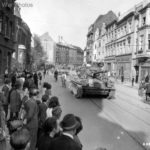M18 and M8 Windsheim 1945
M18 Philipines ’45
Abandoned Königstiger
M18 ETO
M18 705th TDB Miniac-Morvan, France
M18 1944
M18 of the 94th Infantry Division at a repair depot in Germany in early 1945
Jeep and Hellcat of the 8th Armored Division at Rheinberg 6 March 1945
Assembly line at Buick Motor Division of General Motors
Hellcat of the 602nd Tank Destroyer Battalion at Rhine 26 March 1945
Pilot model: 76 mm Gun Motor Carriage T70 of the 894th Tank Destroyer Battalion. Italy May 1944
M18 of the 827th Tank Destroyer Battalion 1944
76 mm Gun Motor Carriage M18 Hellcat in action Brest 1944
Marine Hellcat of the 306th Anti-tank Company Okinawa 11 May 1945
Hellcats in Dusseldorf 20 April 1945
M18s of the 612th Tank Destroyer Battalion, 2nd 2nd Infantry Division in Leipzig 18 April 1945
2nd Armored Division Hellcat during Battle of the Bulge, January 1945
M18 Hellcat of the 827th Tank Destroyer Battalion 1944 2
Hellcat and troops of the 3rd Army move thru Gros Gerau, Germany, March 1945
M18 of the 805th Tank Destroyer Battalion – engine maintenance
Destroyed M18 Hellcat and M15 Halftrack in the background. Bastogne, December 29, 1944
M18 Hellcat in action in Firenzuola Italy 1945
M18 Hellcat Tank Destroyer Built by Buick
M18 Hellcat Tank Destoyers 76mm Guns on the Move in Field
The M18 Hellcat (M18 GMC) was an American tank destroyer of World War II, used in the Italian and European theatres.
Hellcat tank destroyer turned out to be a very unusual piece of weaponry. Due to the differences in the doctrine of the use of armored vehicles by the Americans from Germany and the USSR, it does not look like its “classmates”. According to US military theorists, the abundance of tanks on the battlefield will exclude them from dueling, so tank destroyers were created to fight the enemy’s armored vehicles: weakly armored, but with a good gun and high mobility. The “Hellcat” had all this: the maximum thickness of the armor was 13 mm, which caused a small weight – only 17.7-18 tons. With a 350-400 hp engine, the ACS could develop up to 80 km/h on the highway. Gun – M1A1 caliber 76 mm, which was enough to fight most German tanks. During the Battle of the Bulge, 24 German tanks were credited to the M18 account – for 5 lost Hellcats. According to historians, the main advantage of the machine was the ability to” shoot and run”, relying on high dynamics. Today we will omit the details of the combat path of the American tank destroyer, and look at the internal volumes of the formidable machine from the seats of its crew members. Given the tactics of using the machine, the M18 driver was almost the most important member of the crew: in the case of return fire, the only chance was to escape from it. It was available 400 power 9-cylinder engine Continental R975-C4. This allowed the development of an unprecedented 80 km/h for armored vehicles. The control was performed by levers located non-standard – they went from the roof of the case. The driver’s life was made easier by the Torqmatic 900T automatic transmission with three forward and one reverse gears. The survey was carried out by a rotary periscope M6. Unlike German and Soviet tanks, in the right part of the hull – next to the driver – sat not the shooter-radio operator, but the “driver’s assistant”. He was a backup crew member, and could replace any position. The assistant’s controls are similar to those of the driver. Additionally, the assistant’s hatch had controls for the fire extinguishing system. The position of the first turret was to the left of the breech of the gun. The main tool of the operator of the 76 mm M1A1 gun was the m71d gunner’s telescopic sight, which was supplemented by an M4A1 periscope with a built-in M47A2 telescope. The electrohydraulic drive of the turret rotation provided a high speed of guidance. And angles of declination up to -9 degrees allowed to fire from closed positions. To the right of the gun in the tower is the place of the loader. In front of it was the first-line ammunition stack, which could hold 8 rounds. The main mass of 45 shells is distributed between the sides of the hull and the abandoned niche. The range of projectiles included armor-piercing, sub-caliber, smoke and high-explosive shells. The lightest (smoke) one weighed 6 kilograms, while the M62 armor-piercing one weighed 11.1 kg. At the rear of the tower was the seat of the M18 crew commander. Due to the use of an open cockpit, his observation devices were limited to standard binoculars. The SCR-610 radio station was used for communication, and the RC – 99 device was used for internal negotiations. The only auxiliary armament was a Browning M2HB heavy machine gun mounted on a swivel turret above the commander’s seat (800 rounds).
Reference
- M18 Hellcat Tank Destroyer 1943-97 – Steven J. Zaloga, Osprey Publishing New Vanguard 97
- Allied-Axis 4 – Ampersand Publishing 2002
- Allied Armored Fighting Vehicles 1:72 Scale – World War II AFV Plans – Stackpole books 2009
- American Tanks of World War II – Thomas Berndt, MBI Publishing Company 1994
- AFV Weapons Profile 26
- The Tank Killers – A History of America’s World War II Tank Destroyer Force – Harry Yeide
- Seek, Strike, and Destroy: U.S. Army Tank Destroyer Doctrine in World War II – Dr. Christopher R. Gabel, Leavenworth Papers No. 12
- US Tank and Tank Destroyer Battalions in the ETO 1944-1945 – Steven J. Zaloga, Osprey Battle Orders 10
- Allied Tank Destroyers – Bryen Perrett, Osprey 1979
- US Tank Destroyers in action – Jim Mesko, Squadron/Signal Publications Armor Number 36
- S. Tank Destroyers in Combat 1941-1945 – Steven J. Zaloga, Concord 7005
- US Armored Units in the North African and Italian Campaigns 1942-45 – Osprey Battle Orders 021 (2006)
- US Tank Battles in North Africa and Italy 1943-45 – Steven J. Zaloga, Armor at War Concord 7051
